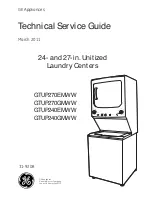
3
ENGLISH
O
peratOr
’
s
M
anual
A
GUIDE RODS. Guides and align the pusher head onto the blade
set.
B
HANDLE. Used to lower and raise the pusher head.
C
LEGS. Supports the equipment.
D
PUSHER HEAD ASSEMBLY. Made up of the guides and the
pusher head block (and the handle for tabletop models).
E
BUMPERS. Cushions the stop of the pusher head.
F
SAFETY LOCK HANDLE. Used to secure the pusher head block
in the up position.
G
BLADE ASSEMBLY. Houses the blades. Specifically sized to
match the corresponding pusher head block.
H
BASE ASSEMBLY. Holds the guide rods and parts of the
equipment.
I
LEG SCREWS. Holds the legs in place.
J
LOCKING PIN. Secures the pusher head to the handle. Secures
the handle assembly to the base. Secures the safety lock to the
base.
K
SAFETY LOCK ARM. Used to secure the pusher head block in
the up position.
u
nPacking
the
e
quiPment
and
i
nitial
S
etuP
Carefully remove crating or packaging materials from the equipment. Dispose
of all packaging ,materials in an environmentally responsible manner.
Leg installation Lettuce King I:
1. Use the screws (A) and washers (B) to install legs (C) tightening with
wrench (D). See Figure 3.
D
A
B
C
Figure 3. Legs, Hardware and Tool for the Lettuce King I.
2. Secure legs (C) to base (E) using screws (A) and washers (B). See
Figure 4.
B
A
B
A
E
E
C
Figure 4. Mounting the Legs on the Lettuce King I.
Leg installation Lettuce King IV:
1. Use the capscrews (A) and rubber washers (B) to install legs (C). See
Figure 5.
B A
B
A
E
E
C
Figure 5. Legs and Hardware for the Lettuce King IV.
2. Set legs (C) into the holes in the base assembly (D) so the angled part of
the leg faces outward. See Figure 5.
3. Secure legs (C) to base assembly (D) using capscrews (A) and rubber
washers (B). See Figure 5.
4. Tighten capscrews (A) slowly and rotate the legs slightly so that the end
of the capscrew (A) enters the notch (E) in the leg (C). See Figure 5.
C
D




































